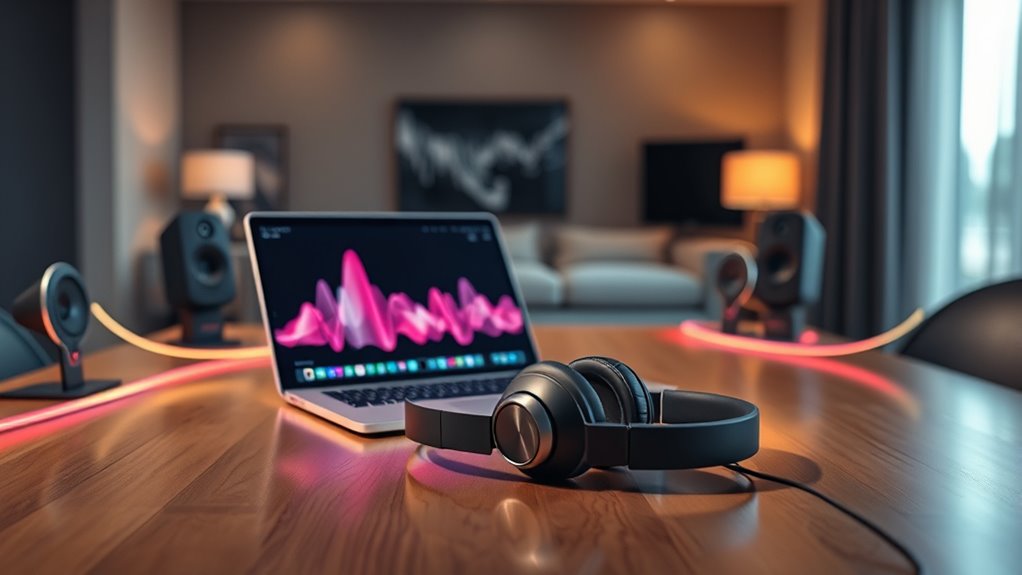Spatial audio surrounds you with sounds from all directions, adding height, depth, and precise localization, making you feel immersed in a 3D environment. In contrast, stereo offers a wide, horizontal soundstage but lacks vertical and behind-your-head cues. You’ll hear spatial audio mainly during movies, games, or VR, where realism matters, while stereo suits everyday listening like music or podcasts. Exploring further reveals how different formats enhance your listening experience and when each works best.
Key Takeaways
- Stereo offers a 2D soundstage with width primarily from left-right panning, while spatial audio creates a 3D environment with height, depth, and positioning.
- You hear clear, wide sound in stereo for everyday media like music and podcasts; spatial audio provides immersive, positional sound for VR, movies, or gaming.
- Spatial audio enables sounds from above, behind, or around you, unlike stereo’s limited horizontal sound placement.
- Stereo playback works with simple headphones or speakers, whereas spatial audio requires specialized hardware like head-tracking headphones or multi-speaker setups.
- Use stereo for casual, everyday listening, and spatial audio when immersive, realistic environments or precise directional cues enhance the experience.
Understanding the Basics of Sound Dimension

Have you ever wondered how we perceive sounds differently depending on their position in space? Stereo audio presents sound in two dimensions, mainly left and right, creating a sense of width but no vertical or depth cues. It’s like looking at a flat painting—you see the scene but don’t feel its height or distance. Stereo sound typically relies on phase differences to create the illusion of directionality, which is effective but limited in spatial perception. This technology mainly works within the boundaries of binaural cues, which are essential for localizing sound sources in a two-dimensional plane. Spatial audio, on the other hand, adds a third dimension, giving sounds height, depth, and position around you. This creates a more realistic experience, making it seem like sounds are coming from above, below, or behind you. While stereo is limited to horizontal placement, spatial audio mimics real-life environments, making you feel more immersed and present in the soundscape. Additionally, head tracking enhances spatial audio by adjusting the sound based on your head movements, increasing realism. Understanding these differences helps you appreciate how sound design technology shapes your listening experiences and enhances spatial awareness.
How Audio Is Mixed and Placed in Space
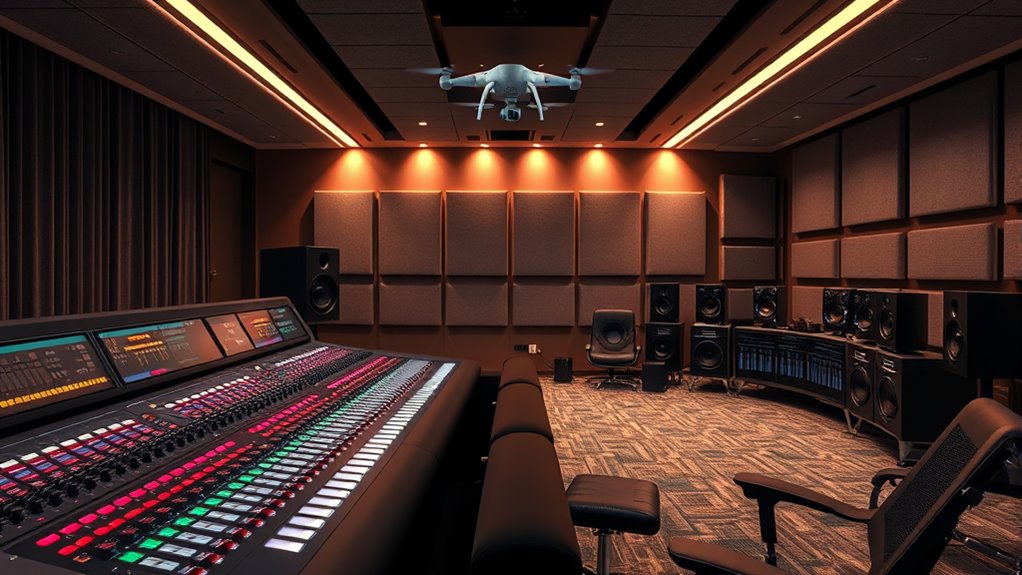
When mixing audio for different environments, the techniques used to place sounds in space vary considerably between stereo and spatial audio. In stereo, you control sound placement through panning, shifting audio between left and right channels to create a sense of width. Spatial audio, however, treats sounds as objects in a 3D environment, allowing for dynamic positioning around you in all directions. Advanced algorithms use metadata to assign sounds to specific locations, including above or behind you. Head-related transfer functions (HRTF) help simulate natural sound cues through headphones. Real-time processing adjusts sound based on your position and head movements, giving a more immersive experience. Additionally, sound localization techniques are employed to accurately position audio sources in three-dimensional space, enhancing realism and spatial awareness. The development of audio rendering technologies continues to improve the authenticity of spatial sound experiences, making them more indistinguishable from real-world sounds. These innovations are supported by our understanding of mindfulness concepts, which emphasize awareness and presence, aligning with the goal of creating truly immersive audio environments.
Hardware and Playback Differences in Sound Formats
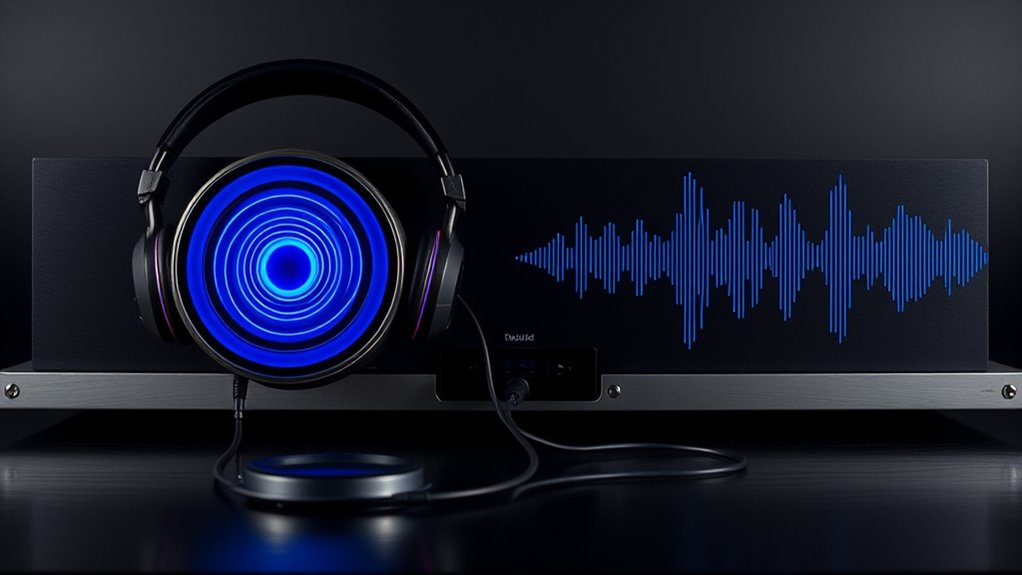
While stereo audio relies on two channels and fixed left-right separation, spatial audio demands specialized hardware to fully realize its three-dimensional soundscape. Standard stereo playback uses simple headphones or speakers that deliver sound from two fixed points. In contrast, spatial audio requires advanced setups like multi-speaker arrays, upward-firing drivers, or headphones equipped with head-tracking sensors. These devices adjust sound positioning based on your movement and room acoustics, creating a more immersive experience. Many formats, like Dolby Atmos, are backward compatible with stereo systems but offer richer experiences on compatible hardware. Head-tracking headphones can dynamically shift sound sources as you move, while room-based systems use multiple speakers to simulate height, depth, and surround effects. This hardware complexity enhances realism and spatial accuracy beyond traditional stereo. Advanced hardware makes a significant difference in achieving authentic spatial audio experiences. Additionally, the spatial audio technology can adapt to various environments, ensuring consistent sound quality regardless of room acoustics. This adaptability is made possible through specialized hardware, which is essential for delivering precise spatial cues. As a result, spatial sound formats continue to evolve, providing even more precise and immersive audio experiences for users. Furthermore, ongoing technological advancements are driving improvements in how spatial audio is integrated into consumer devices, broadening accessibility and user experience.
The Impact on Sound Localization and Immersion
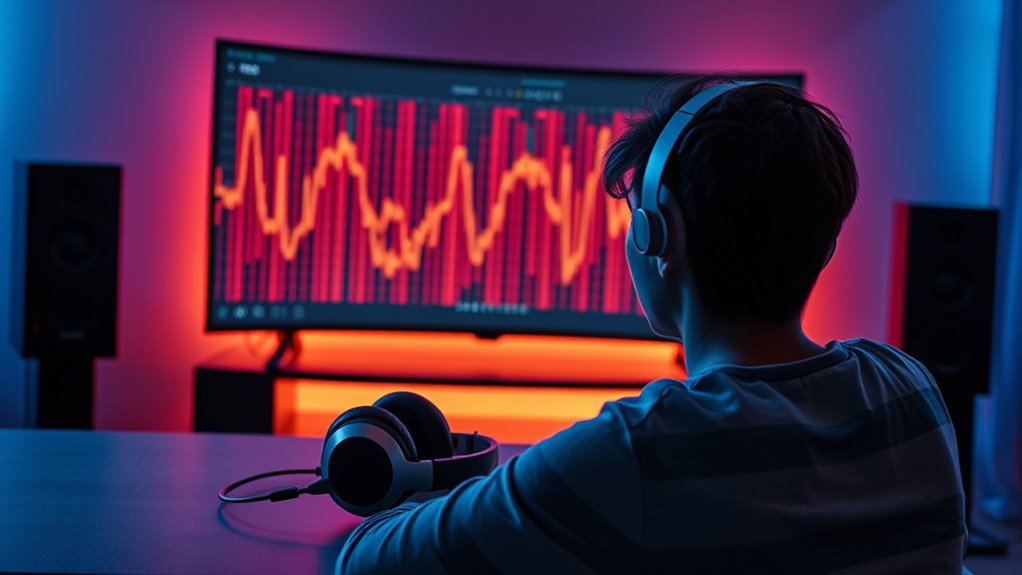
Spatial audio substantially enhances sound localization by providing precise cues that place sounds within a three-dimensional space, unlike stereo’s limited horizontal perspective. It allows you to perceive sounds as coming from above, below, behind, or in front, creating a more realistic experience. This immersive quality heightens emotional engagement and makes virtual environments feel genuine. You’ll notice that sounds are more accurately positioned, reducing the ‘phantom’ images common in stereo. The use of subtle timing, frequency shifts, and head-tracking techniques improves directional accuracy. As a result, your brain interprets spatial cues more naturally, boosting overall immersion. Additionally, AI advancements are increasingly used to refine the accuracy of spatial sound rendering, making virtual audio environments even more convincing.
Ideal Uses and Content Types for Each Format
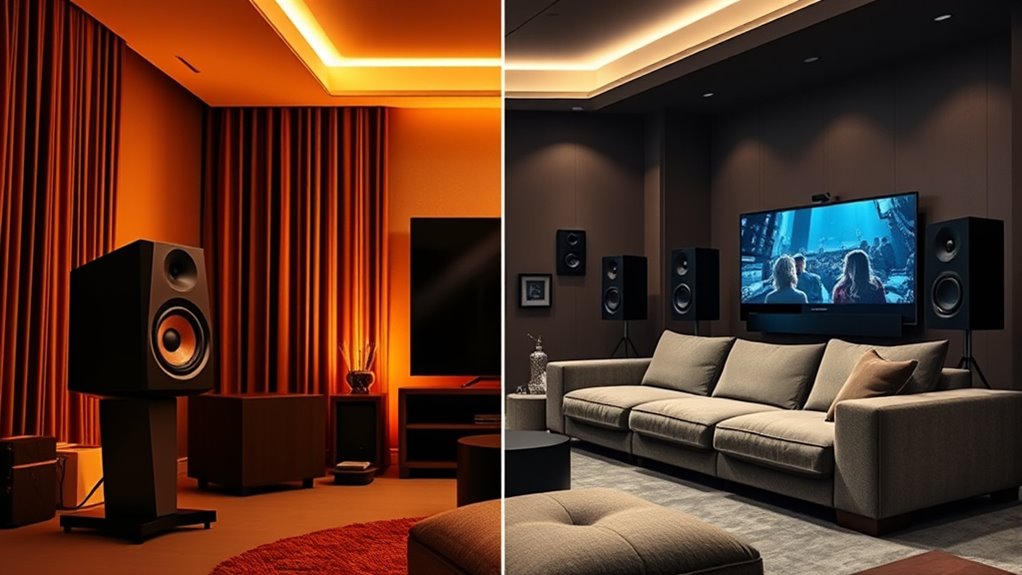
Stereo audio is ideal for everyday listening, such as music, podcasts, and radio broadcasts, where a straightforward, wide sound stage suffices. It provides clear separation between left and right channels, making it perfect for casual use and standard media. When you’re enjoying familiar content or background music, stereo’s simplicity makes it accessible and easy to enjoy without special equipment. Additionally, understanding audio formats can help you choose the best listening experience for your needs. Exploring how different brewing techniques influence flavor can also enhance your appreciation of the media you consume. Knowing about car tuning upgrades can inspire you to customize your audio setup for optimal sound quality. In contrast, spatial audio excels with immersive media like movies, virtual reality, gaming, and live concert simulations. It creates a three-dimensional environment, allowing sounds to come from above, behind, or around you, increasing realism and engagement. Creative projects like ambient or electronic music also benefit from spatial audio’s depth and movement, delivering a richer, more dynamic experience. Additionally, sound design leveraging spatial audio can significantly elevate the emotional impact and realism of multimedia content.
Frequently Asked Questions
Can Stereo Sound Be Upgraded to Simulate Spatial Audio?
Yes, stereo sound can be upgraded to simulate spatial audio using various techniques. You can use software or hardware with algorithms like HRTF to create a 3D effect, making sounds appear above, below, or around you. Head-tracking headphones and specialized speakers can enhance this experience further. While it’s not true spatial audio, these upgrades considerably improve immersion, making your listening experience feel more natural and engaging.
How Does Head-Tracking Improve Spatial Audio Experiences?
Head-tracking boosts your spatial audio experience by dynamically adjusting sound based on your head movements. When you turn your head, the system recalibrates the sound sources, making them seem fixed in space. This creates a more realistic, immersive environment, as if you’re physically present in the scene. It enhances localization, depth, and stability of sound, making virtual environments feel natural and engaging, especially in VR, gaming, and high-quality listening setups.
Are Spatial Audio Formats Compatible With All Headphones and Speakers?
Think of spatial audio formats as a universal language that can speak to most headphones and speakers. While many formats like Dolby Atmos are compatible with a wide range of devices, full experience often depends on hardware support. Some headphones and speakers might only offer basic stereo sound, limiting spatial effects. To access the full potential, using compatible, dedicated spatial audio devices guarantees you hear sounds in immersive, three-dimensional clarity.
What Are the Main Technical Challenges in Producing Spatial Audio?
The main technical challenges in producing spatial audio include managing complex 3D sound rendering, which demands high computational power for real-time processing. You also need precise sound object placement and accurate head-tracking to create immersive experiences. Additionally, integrating various hardware setups and ensuring compatibility across devices can be tricky, as you must optimize audio cues for different environments while maintaining natural localization and avoiding latency issues.
Does Spatial Audio Require More Bandwidth for Streaming?
Yes, spatial audio generally requires more bandwidth for streaming because it delivers a richer, three-dimensional sound experience. You need extra data to transmit the complex sound positioning, multiple channels, and object metadata used to create the immersive environment. This increased data load can impact streaming quality, especially on slower networks. To guarantee smooth playback, streaming services often compress or optimize spatial audio formats, but it still needs more bandwidth than stereo.
Conclusion
By choosing between spatial audio and stereo, you’re opening a sound experience so immersive, it’s like stepping into a whole new universe. Imagine feeling every whisper, explosion, or musical note swirl around you—completely transforming how you experience media. Whether you’re gaming, watching movies, or listening to music, the right format can elevate your senses to mind-blowing levels. Don’t settle for ordinary—dive into the future of sound and let your ears be amazed!
